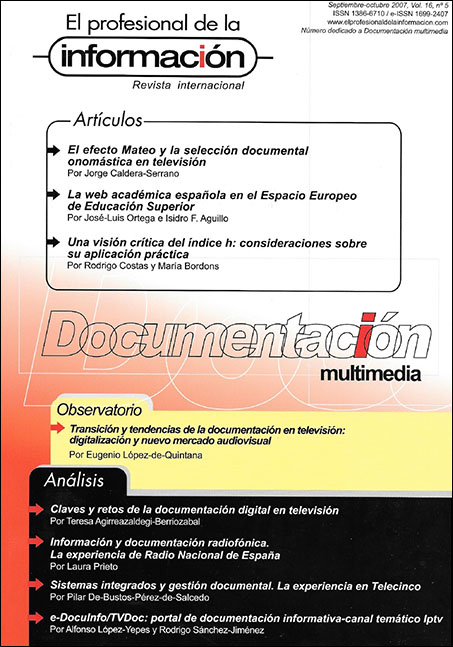Radiophonic information and documentation: Spaces for common interest. The experience of Spanish National Radio (RNE)
DOI:
https://doi.org/10.3145/epi.2007.sep.06Keywords:
Radiophonic information, Radio programs, Generalist radio programs, Informational radio programs, News radio, Radio theatre, Specialized radio programs, Radiophonic documentation, Recorded music, non-music recordings, Written radiophonic informationAbstract
Radiophonic information includes three types of materials: music recordings, non-music recordings, and written material. Considering the qualitative rather than quantitative aspects of the extent to which different types of programs use them, the user needs range from the most general to the most specialized content. RNE, the Spanish national radio network, serves as a case study of the relationship between radiophonic information and documentation. The center for radio documentation, at the service of professional needs, plans the document chain based on typology and then addresses the need to respond to general as well as specialized queries. All of this occurs within the framework of new digital technologies that affect broadcasting as well as handling and preservation of information.
Downloads
Downloads
Published
How to Cite
Issue
Section
License
Dissemination conditions of the articles once they are published
Authors can freely disseminate their articles on websites, social networks and repositories
However, the following conditions must be respected:
- Only the editorial version should be made public. Please do not publish preprints, postprints or proofs.
- Along with this copy, a specific mention of the publication in which the text has appeared must be included, also adding a clickable link to the URL: http://www.profesionaldelainformacion.com
- Only the final editorial version should be made public. Please do not publish preprints, postprints or proofs.
- Along with that copy, a specific mention of the publication in which the text has appeared must be included, also adding a clickable link to the URL: http://revista.profesionaldelainformacion.com
Profesional de la información journal offers the articles in open access with a Creative Commons BY license.




